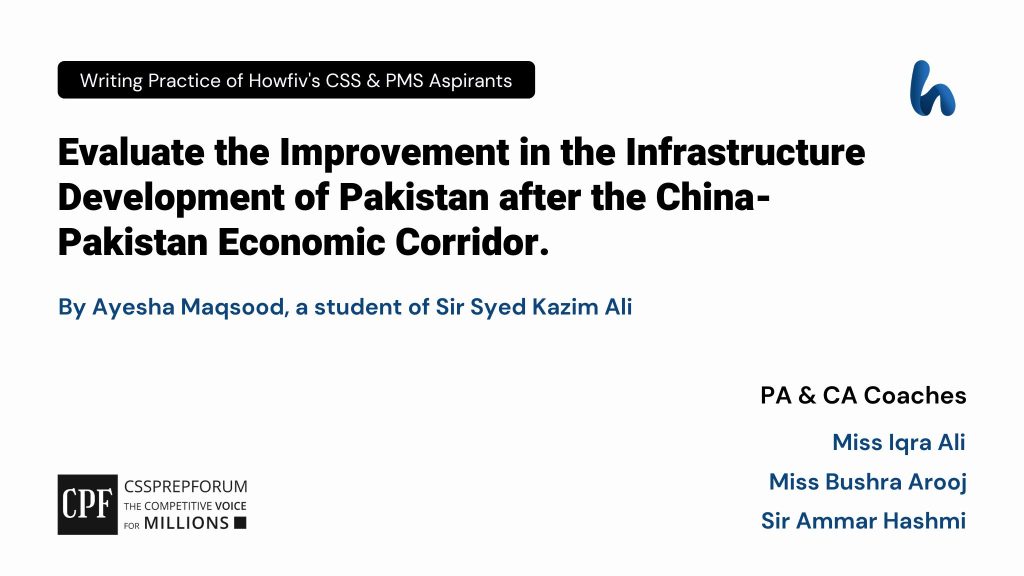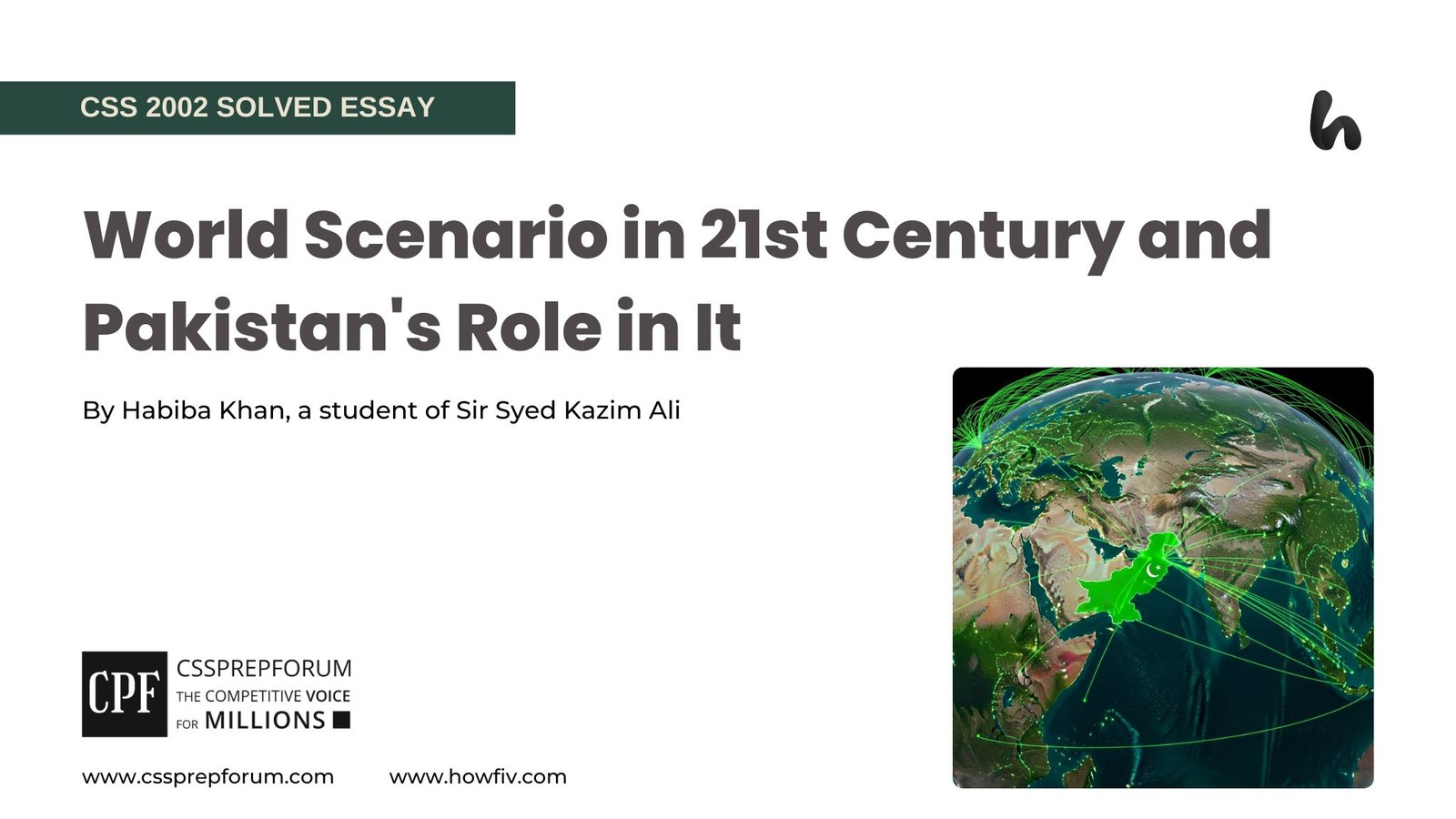CSS Pakistan Affairs | The Improvement in Pakistan’s Infrastructure after CPEC
The following question of CSS Current Affairs is solved by Ayesha Maqsood under the supervision of Howfiv’s Pakistan Affairs and Current Affairs Coaches. She learnt how to attempt 20 marks question and essay writing from Sir Syed Kazim Ali, Pakistan’s best CSS and PMS English essay and precis teacher with the highest success rate of his students. This solved past paper question is attempted on the pattern taught by Sir to his students, scoring the highest marks in compulsory and optional subjects for years, and uploaded to help aspirants understand how to crack a topic or question, how to write relevantly, what coherence is, and how to include and connect ideas, opinions, and suggestions to score the maximum.

Outline
1-Introduction
2-Elucidating the term CPEC, its institutional framework, and its phases
3-Understanding the CPEC’s significance and potential, vision, and mission
4-Throwing light on the initial conditions of Pakistan’s infrastructure, pre-CPEC
5-Improvements in Pakistan’s infrastructural development, post-CPEC
- ✓ Transport Infrastructure
- Case in point: According to the National Highway Authority, 2024, the CPEC set its target of about 1719km of total lengths and highways, completing its target of about 1044km (61% progress) and under construction being about 675km (39% progress remaining)
- ✓ Energy Infrastructure
- Case in point: According to the CPEC Authority, the CPEC setting its target of about 11748MW of total installed capacity, completing its target of about 9444MW (80% progress) and under-construction being about 2304MW (20% progress)
- ✓ Gwadar port
- Case in point: According to the Gwadar Port Authority, the CPEC having an investment budget of about 1.153 billion dollars for the construction of Gwadar, of which about 643 million dollars being invested and a completed target of about (56% progress), and the remaining is about 510 million dollars (44% progress left)
- ✓ Special Economic Zones
- Case in point: According to the Collective Provincial (Punjab, KPK, Sindh, and Balochistan) Board of Investment of Pakistan, the CPEC designing 9 SEZs from which 4 have completed its infrastructural development and estimating progress of about 44% and under-constructed projects being 5 and the remaining progress of about 56%
- ✓ Optical Fiber Cable Projects
- Case in point: According to the Special Communication Organization, 2024, the CPEC setting its target of about 6000k from which achieving its target of about 4500km and estimating the progress of about 75%, and under-constructed being about 1500km and estimating the progress of about 25%
6-Remedial measures to increase the efficiency of the CPEC in improving infrastructure
- ✓ To eliminate the governance problems by stabilising the tenure of the Government
- ✓ To implement rigid policies of CPEC by reforming documentation with Pakistan’s unstabilised successive governments
- ✓ To increase the funds by collecting revenues and taxes and investing them in the CPEC’s infrastructure project
7-Critical Analysis
8-Conclusion

Answer to the Question
Introduction
The China-Pakistan Economic Corridor lies at the crossroads of South Asia and plays a significant role in socioeconomic, political and technological development at the regional and state level. Its importance can be determined by its objectives and principles, which provide opportunities to countries for regional connectivity in terms of trade and commerce, stability and peace. Various domains of the CPEC work in Pakistan, have been focused on the improvement of the infrastructure. Nevertheless, Pakistan has rusted its infrastructure since its inception, and due to successive governments, various institutions have failed to improve the infrastructure. Currently, Pakistan has improved its infrastructure after the initiation of the CPEC. Although some internal and external factors have derailed its progress, Pakistan has not achieved 100% improved infrastructure. However, the CPEC has, up to some extent, improved the infrastructure of Pakistan, which has been fostering its economy by providing various fruits to Pakistan’s nation. According to the World Bank Report (2024), in the 9-year development phase, Pakistan has been strengthening its economy by about 2-3% due to CPEC and improving infrastructure by about 55% on average. The CPEC has improved the transport infrastructure, energy sectors, special economic zones, optical fibre cable projects, telecommunication infrastructure, and Gwadar port. Various sub-projects have also been initiated to digitalise the infrastructure by incorporating it with telecommunication sources. It creates opportunities for jobs, healthcare, education, and transport, and provides necessities of life. Thus, the CPEC is a game changer for Pakistan’s development in terms of improved infrastructure and fostering the economy by increasing revenues.
The CPEC, its institutional framework and its phases
Decoding the term “the CPEC’’, the China-Pakistan Economic Corridor, at the crossroads of South Asia, is a ray of hope for Pakistan’s development connecting China’s Xinjiang region with Pakistan’s Gwadar Port through various projects. It is a flagship project of BRI and a game-changer for regional connectivity, including China, Pakistan, Central Asian Republicans, the Middle East and Europe for trade and investments. The main components of the CPEC are energy projects, transportation networks, Special Economic Zones, Gwadar Port and fibre optic cables. These components enhance Pakistan’s geostrategic importance. This project is divided into three phases: Short-term (2015-2020), which focuses on energy and structure; Medium-term (2020-2025), which focuses on Industrialization and Special Economic Zone development; and Long-term (2025-2030), which focuses on regional connectivity and trade expansion. Hence, CPEC is the project that creates regional stability and peace and lies at the crossroads of South Asia.
CPEC Significance and Potential, Vision, and Mission
The CPEC is significant for the development of the region. Potential areas of development include regional connectivity, diverse investment opportunities, industrial cooperation, financial cooperation, agricultural cooperation, socioeconomic development, tourism promotion, educational linkage, human resource development, people-to-people contact, increased livelihood opportunities, and enhanced security and stability of the region. Going ahead, The CPEC has diversified its vision and mission, including integrated transport, IT systems and data communication channels, energy cooperation, spatial layout, financial zones, industries and industrial parks, and agricultural and socioeconomic development. Its vision and mission are mainly its significance and potential. Thus, development is the backbone of the CPEC’s vision and mission, which fosters its potential to improve the infrastructure.
Throwing light on the initial conditions of Pakistan’s infrastructure, pre-CPEC
Since its inception, Pakistan’s infrastructure has been very rusty and is unable to foster the economy of Pakistan. Its main reasons are void of the leadership gap between the nation and the country’s development. Inappropriate policies have devastated its infrastructure consistently. According to the World Bank Report, ‘Pakistan Overview 2015’, Pakistan’s energy deficit is 4000-5000MW, resulting in frequent power outages due to poor infrastructure of energy sectors, Pakistan’s road density is only 32km per 1000 sq. km due to rusty infrastructure of transport, Pakistan’s ports operate at only 60% capacity due to inadequate infrastructure and inefficient operations Pakistan’s mobile penetration rate is only 67% due to inappropriate policies and poor telecommunication infrastructure, and Pakistan’s management system is inefficient in water management, with an estimated 50% of water being wasted due to leakage and other losses. These statistics show that Pakistan has inadequate infrastructure and has failed to improve it despite the many natural resources present in Pakistan. However, Pakistan’s government has always been unable to improve its infrastructure. It led to the poor economy of Pakistan and hindered the development progress due to inappropriate policies made by the governments. Thus, poor infrastructure stops Pakistan’s development from the time of independence.
Improvements in Pakistan’s infrastructural development, post-CPEC (Currently)
After the CPEC, Pakistan has made achievements in improving the development of infrastructure. Based on these targets and achievements, the CPEC has divided the domains relating to infrastructure into various initiatives.
- Transport Infrastructure
The CPEC has initiated the project, which works on the improvement of the infrastructure. The main focus of this domain is improving roads, highways and motorways. This project has set its target to achieve its progress and in collaboration with Pakistan’s ministry, the CPEC has been working on it. From 2015 to 2024, it has achieved its target to some extent. According to the National Highway Authority, 2024, the CPEC has set its target of about 1719km of total lengths and highways, completed its target of about 1044km (61% progress) and under-construction is about 675km (39% progress remaining). This shows that Pakistan’s infrastructure has improved by about 61% in just constructing roads, highways and motorways. The 39% of progress derails due to successive governments from being its initiation. Thus, the CPEC is a game changer for Pakistan’s infrastructural development and improves the transport sector significantly.
- Energy Infrastructure
The CPEC has introduced another domain, which primarily works in the construction of the energy sector. It has launched modern types of machinery in the energy sector. It has been boosting Pakistan’s GDP. Moreover, it provides jobs and removes the shortages of electricity. According to the CPEC Authority, the CPEC has set its target of about 11748MW of total installed capacity, completed its target of about 9444MW (80% progress) and under-construction is about 2304MW (20% progress). This shows that nearly the CPEC has achieved its target of improving the energy sector. It helps in generating revenue and boosts the economy. Further, it lessens dependence on other countries, importing electricity and energy resources. Thus, the CPEC has improved the energy sector’s infrastructure and decreased over-dependence on other countries.
- Gwadar Port
Pakistan’s game changer, the Gwadar port, has been improved due to the initiation of the CPEC. This domain’s importance lies in trading and commerce purposes. Therefore, it is important for regional connectivity. Many projects have been worked on improving the infrastructure of the Gwadar port. According to the Gwadar Port Authority, the CPEC has an investment budget of about 1.153 billion dollars for the construction of Gwadar, of which about 643 million dollars has been invested and a completed target of about (56% progress), and the remaining is about 510 million dollars (44% progress left). This shows that, to some extent, Gwadar has been constructed and participated in boosting the country’s economy. This project provides job opportunities, necessities of life and security to the Gwadar people. Thus, Gwadar’s infrastructure is the backbone of the country’s economy, and the CPEC has increased its importance at the regional level.
- Special Economic Zones
Special Economic Zones in Pakistan have changed Pakistan’s destiny in terms of economy and sustainable development. It attracts foreign investment and helps in fostering the GDP of the country. Moreover, it helps in alleviating the poverty rate, illiteracy rate, unemployment and other socioeconomic evils from the root. Therefore, Pakistan’s Ministry of Trade and Commerce, in collaboration with the wing of the CPEC, has started work in these zones. According to the Collective Provincial (Punjab, KPK, Sindh, and Balochistan) Board of Investment of Pakistan, the CPEC has designed 9 SEZs from which 4 have completed its infrastructural development and estimated progress of about 44% and under-constructed projects are 5 and the remaining progress of about 56%. This shows that about 44% of infrastructure in these zones has improved, and this has increased the country’s GDP by about 2-3% yearly. This helps in regional connectivity and decreases dependence on others. Thus, Special Economic Zones are of significant importance in trading and commerce.
- Optical Fiber Cable projects
This domain focuses on the installation of modern optical fibre cables in other infrastructure sectors. This decreases the security threats by incorporating silicon chips into transport infrastructure, and in machinery, it incorporates the alarming system that will reduce the inefficiency of the energy sector. Special fibres have been incorporated in the SEZs and Gwadar port. According to the Special Communication Organization, 2024, the CPEC has set its target of about 6000k, from which it has achieved its target of about 4500km and estimated progress of about 75%, and under-constructed is about 1500km and estimated progress of about 25%. This shows that network channels have been spreading throughout the country, increasing access to the internet and helping to detect alarming threats. Thus, the CPEC has improved its infrastructure and strengthened its efficiency by incorporating optical fibre cables.
Overall, CPEC has made significant progress in its infrastructural development based on targets and achievement. The total percentages on the basis are,
- Transport infrastructure: 32.4%
- Energy infrastructure: 71.6%
- Telecommunication infrastructure: 75%
- Gwadar Port: 55.7%
- SEZs: 44.4%
The total percentage in infrastructure improvement is around 58% taking all on average.
Remedial measures to increase the efficiency of the CPEC in improving infrastructure
To complete the remaining target, the CPEC should take remedial measures. Some are given below,
- ✓ To eliminate the governance problems by stabilising the tenure of the Government
- ✓ To implement rigid policies of CPEC by reforming documentation with Pakistan’s unstabilised successive governments
- ✓ To increase the funds by collecting revenues and taxes and investing them in the CPEC’s infrastructure project
Critical Analysis
Critically, initial conditions hindered the development process of Pakistan, but after the CPEC, various domains were introduced to improve Pakistan’s infrastructure. Nowadays, the CPEC has improved the infrastructure significantly and is helping boost the country’s economy. The achievements that have not been taken by Pakistan’s government, the CPEC have achieved by implementing efficient policies. Moreover, it decreases the dependence on other countries, which shows the disability of Pakistan’s governments. Pakistan’s infrastructure is now in good condition. But it needs some improvements to meet the level of the West. Hence, the CPEC is a game changer for Pakistan’s development and economy.
Conclusion
In a nutshell, the CPEC has, up to some extent, achieved its target, can be seen by observing conditions of roads, highways, motorways, energy sectors, telecommunication department, Gwadar Port and Special Economic Zones. The CPEC, through its adequate policies, has improved Pakistan’s poor and rusty infrastructure. Thus, the CPEC is the game changer for Pakistan and increases its geostrategic importance by making it important for the region for trade and commerce purposes. Hence, the China-Pakistan Economic Corridor plays a role in boosting socioeconomic, political, and technological development.

CSS Solved Past Papers’ Essays
Looking for the last ten years of CSS and PMS Solved Essays and want to know how Sir Kazim’s students write and score the highest marks in the essays’ papers? Then, click on the CSS Solved Essays to start reading them.
CSS Solved Essays
CSS Solved Islamiyat Past Papers
Want to read the last ten years’ Islamiyat Solved Past Papers to learn how to attempt them and to score high? Let’s click on the link below to read them all freely. All past papers have been solved by Pakistan’s top CSS Islamiyat coach having the highest score of their students.
CSS Solved Islamiyat
CSS Solved General Science & Ability Past Papers
Want to read the last ten years’ General Science & Ability Solved Past Papers to learn how to attempt them and to score high? Let’s click on the link below to read them all freely. All past papers have been solved by Pakistan’s top CSS GSA coach having the highest score of their students.
CSS Solved General Science & Ability












